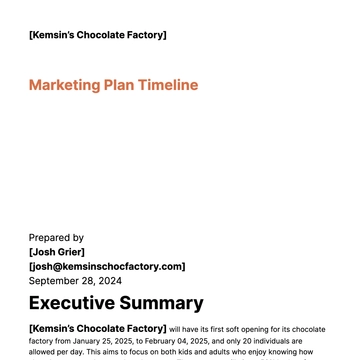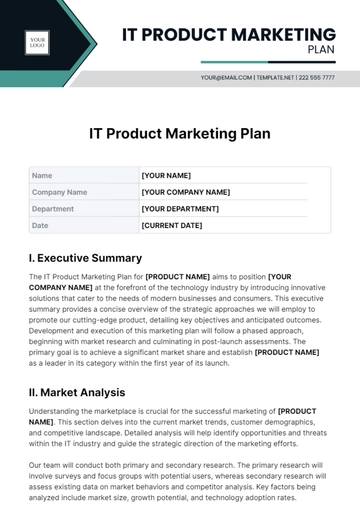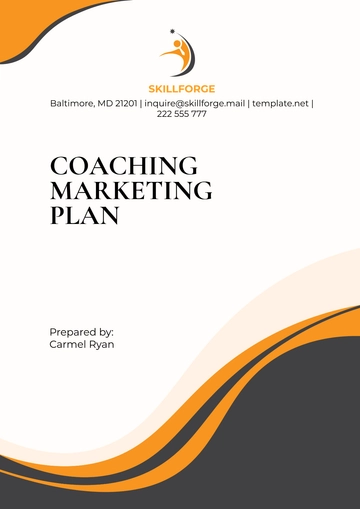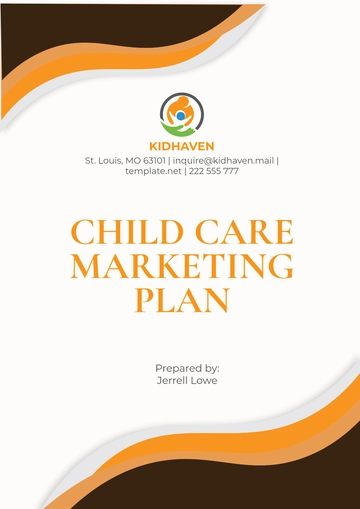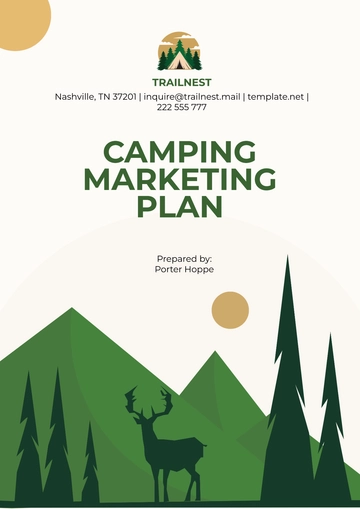Free Yoga Studio Marketing Plan

1. Executive Summary
The purpose of this marketing plan is to outline comprehensive strategies and tactics that [Your Company Name] will implement to enhance brand visibility, attract new customers, and retain existing clients in the dynamic fitness and wellness industry of 2050 and beyond. As we progress through the years, the demand for holistic health practices such as yoga continues to rise, driven by an increasing awareness of the importance of physical and mental well-being. This marketing plan encompasses a multi-faceted approach that integrates digital marketing, community engagement, partnerships, and customer loyalty programs to position [Your Company Name] as a leader in the wellness community.
Our focus will be on creating a strong brand identity that resonates with our target audience, offering exceptional customer experiences, and establishing meaningful connections within the community. The plan will also address the importance of adapting to emerging trends, technological advancements, and consumer preferences as they evolve in the coming years. This forward-thinking approach will ensure that [Your Company Name] remains relevant and competitive in the ever-evolving landscape of yoga and wellness.
2. Market Analysis
2.1 Industry Overview
The yoga industry is projected to experience substantial growth, with the global market size anticipated to reach approximately [$66 billion] by 2050. This remarkable growth can be attributed to several factors, including a shift toward preventative health measures, a greater focus on mental health, and an increasing desire among individuals to incorporate holistic practices into their lifestyles.
Market Drivers:
There is a growing awareness of the mental health benefits associated with yoga, including stress reduction, improved mood, and enhanced emotional well-being.
The rise in chronic illnesses, coupled with an aging population, is prompting individuals to seek alternative health solutions that emphasize natural healing and wellness.
Yoga has gained immense popularity as a lifestyle choice among millennials and Generation Z, who prioritize wellness, sustainability, and self-care in their daily routines.
2.2 Target Market
[Your Company Name] will focus on several key segments within the yoga community to ensure our marketing efforts are tailored and effective:
Target Market Segment | Description | Estimated Size (2050) |
|---|---|---|
Young Professionals | Ages [25-35], seeking stress relief and fitness, often juggling careers and personal lives. | [1.2 million] |
Health-Conscious Adults | Ages [35-50], prioritizing physical health and wellness, interested in holistic approaches to fitness. | [1 million] |
Seniors | Ages [50+], looking for low-impact fitness options to enhance mobility and maintain health as they age. | [800,000] |
Families | Parents seeking activities for themselves and their children, valuing wellness and quality family time. | [600,000] |
This segmentation allows us to tailor our marketing messages and offerings to meet the unique needs and preferences of each group. By understanding the motivations of these demographics, [Your Company Name] can create a welcoming environment that appeals to their desires for community, health, and well-being.
2.3 Competitive Analysis
To effectively position [Your Company Name] in the market, a thorough understanding of the competitive landscape is essential. Key competitors in the local market include:
Competitor Name | Strengths | Weaknesses |
|---|---|---|
Zen Yoga Studio | Established brand with a loyal customer base and high-quality instructors who create a supportive environment. | High membership fees that may deter new members looking for affordability. |
Flow Yoga Center | Diverse class offerings that cater to different skill levels and preferences, fostering inclusivity. | Limited online presence, making it difficult for potential customers to discover their offerings. |
Serenity Yoga | Strong community engagement with a variety of workshops and events that attract local participants. | Inconsistent class schedules that can frustrate loyal customers seeking reliability. |
By analyzing these competitors, [Your Company Name] can identify gaps in the market, capitalize on their weaknesses, and leverage our unique strengths to offer unparalleled value to our members.
3. Marketing Objectives
To measure the success of our marketing efforts, [Your Company Name] will pursue the following objectives:
Increase Membership: Achieve a [25%] increase in new memberships within the first year, focusing on converting trial members into long-term clients.
Enhance Brand Awareness: Improve brand recognition by [30%] among our target demographics through strategic social media campaigns and community outreach initiatives by [2051].
Boost Retention Rates: Improve member retention rates by [15%] through enhanced customer service, targeted communication, and loyalty programs by [2051].
Expand Class Offerings: Introduce [5] new specialized classes, such as prenatal yoga, yoga for seniors, and family yoga, by the end of [2051] to attract diverse clientele.
These objectives will provide clear goals for our marketing initiatives, allowing us to track progress and make adjustments as needed.
4. Marketing Strategies
4.1 Branding
A strong branding strategy is vital for [Your Company Name] to establish its identity and connect with our target audience. Our branding initiatives will include:
Logo and Tagline: Developing a modern, inviting logo that encapsulates our mission, paired with a tagline such as "Find Your Inner Peace" that resonates with our commitment to wellness and mindfulness.
Brand Voice: Establishing a brand voice that is friendly, supportive, and encouraging, reflecting our dedication to providing a nurturing and inclusive environment for all members.
Color Scheme: Choosing soft, calming colors that evoke feelings of tranquility and wellness, creating a visually appealing atmosphere both online and in our physical studio.
A consistent and appealing brand identity will be crucial for building trust and loyalty among our members.
4.2 Digital Marketing
In the digital age, having a strong online presence is essential for attracting and retaining customers. Our digital marketing strategy will encompass several key components:
4.2.1 Website Development
User-Friendly Design: A well-designed, intuitive website will allow easy navigation for users seeking class schedules, membership information, and educational blog content. The design will be responsive, ensuring it is accessible across devices.
SEO Optimization: Implementing effective search engine optimization (SEO) strategies will help ensure that [Your Company Name] ranks high in search results for keywords related to yoga, wellness, and local fitness options, driving organic traffic to our site.
Online Booking System: A seamless online booking system for classes and events will enhance user experience, making it easy for members to sign up for classes, workshops, and special events.
By focusing on these aspects, we can create an online platform that serves as an essential resource for our members and potential clients.
4.2.2 Social Media Marketing
Platforms: We will primarily focus on Instagram, Facebook, and TikTok to reach a broader audience, utilizing their unique features to showcase our offerings.
Content Strategy: Our social media content will include engaging visuals and videos, such as:
Short yoga tutorials to provide value and showcase our instructors’ expertise.
Wellness tips and motivational quotes to inspire our followers and create a sense of community.
User-generated content that highlights our members' experiences and transformations, fostering a deeper connection with our audience.
Engagement: Actively responding to comments and messages will foster community engagement, encouraging followers to interact with our brand and each other.
Social media will play a crucial role in building our community and attracting new members.
4.2.3 Email Marketing
Newsletter Campaigns: Monthly newsletters will be sent to our members, featuring upcoming events, special offers, wellness tips, and success stories from fellow yogis. This will keep our community informed and engaged.
Personalization: Tailoring emails based on members’ class preferences and interests will help enhance their experience and make them feel valued, encouraging loyalty to our studio.
Email marketing will serve as a direct line of communication, helping us build lasting relationships with our members.
4.3 Community Engagement
Building meaningful relationships within the community is key to fostering loyalty and attracting new members. Strategies for community engagement include:
Free Community Classes: Offering monthly free classes in local parks will promote health and wellness while introducing new individuals to our studio in a welcoming, pressure-free environment.
Partnerships: Collaborating with local businesses, such as health food stores and wellness centers, will allow us to create cross-promotional opportunities and co-host events, expanding our reach within the community.
Workshops and Events: Organizing workshops on yoga philosophy, mindfulness practices, and nutrition will attract new members and deepen connections with our existing clientele.
Through these community engagement initiatives, [Your Company Name] will establish itself as a trusted resource for health and wellness in the area.
4.4 Customer Loyalty Programs
To encourage member retention and reward loyalty, [Your Company Name] will implement a robust customer loyalty program:
Membership Rewards: A points system will be established, allowing members to earn points for attending classes, referring friends, and purchasing products, which can be redeemed for discounts and exclusive offers.
Exclusive Offers: Members will gain access to members-only workshops, events, and discounts on merchandise, enhancing their overall experience and fostering a sense of belonging.
By offering valuable rewards, we will create incentives for members to remain engaged with our studio long-term.
5. Implementation Plan
5.1 Timeline
The following timeline outlines the key milestones for implementing the marketing plan, ensuring we stay on track to achieve our objectives:
Milestone | Target Date |
|---|---|
Launch revamped website | [April 2050] |
Begin social media campaigns | [May 2050] |
Host first community class | [June 2050] |
Roll out email marketing campaigns | [July 2050] |
Launch customer loyalty program | [August 2050] |
Evaluate progress and adjust strategies | [November 2050] |
5.2 Budget
A preliminary budget for the marketing plan will allocate funds across various initiatives, ensuring effective resource management:
Expense Category | Estimated Budget |
|---|---|
Website Development | [$5,000] |
Digital Marketing | [$7,000] |
Community Engagement | [$3,000] |
Customer Loyalty Programs | [$2,000] |
Miscellaneous (printing, events) | [$1,000] |
Total Estimated Budget | [$18,000] |
6. Evaluation and Measurement
To determine the effectiveness of our marketing initiatives, [Your Company Name] will establish key performance indicators (KPIs) to track progress and make data-driven adjustments:
Membership Growth: Monitor the number of new memberships and retention rates monthly.
Website Analytics: Analyze website traffic, bounce rates, and conversion rates to evaluate the effectiveness of our digital marketing efforts.
Social Media Engagement: Track follower growth, engagement rates, and post reach to measure the impact of our social media campaigns.
Community Event Participation: Evaluate attendance and engagement at community classes and events to gauge interest and adjust offerings accordingly.
Regular assessment of these KPIs will ensure [Your Company Name] stays on target to achieve its marketing objectives, fostering a thriving yoga community for years to come.
7. Risk Management
While [Your Company Name] is poised for success with the outlined marketing strategies, it is essential to acknowledge potential risks and develop strategies to mitigate them. The following are key risks that could impact our marketing efforts, along with corresponding mitigation strategies:
7.1 Market Risks
7.1.1 Competition
Risk: The emergence of new yoga studios or wellness centers may intensify competition, impacting our ability to attract and retain members.
Mitigation Strategy: To counteract this risk, [Your Company Name] will continuously monitor market trends and competitor activities. We will focus on differentiating our offerings through unique class styles, exceptional customer service, and community engagement initiatives that build lasting relationships with our members.
7.1.2 Economic Downturns
Risk: Economic instability may lead to reduced discretionary spending, affecting membership sales and class attendance.
Mitigation Strategy: During economic downturns, [Your Company Name] will implement flexible pricing options, including discounted membership rates, class packages, and special promotions to attract cost-conscious customers. Additionally, we will enhance our value proposition by emphasizing the mental and physical health benefits of yoga, positioning it as an essential service rather than a luxury.
7.2 Operational Risks
7.2.1 Instructor Availability
Risk: High turnover rates among yoga instructors can disrupt class schedules and affect service quality.
Mitigation Strategy: To reduce turnover, [Your Company Name] will prioritize creating a positive work environment that fosters professional development and growth. This includes offering competitive compensation, providing ongoing training opportunities, and promoting a culture of collaboration and support.
7.2.2 Facility Management
Risk: Issues related to facility maintenance or safety can impact the overall member experience and reputation.
Mitigation Strategy: We will conduct regular facility inspections to ensure that our studio meets safety standards and remains well-maintained. Implementing a clear communication channel for members to report concerns will help us address issues promptly, ensuring a positive experience for all.
7.3 Technological Risks
7.3.1 Cybersecurity Threats
Risk: Increasing reliance on technology exposes [Your Company Name] to potential cybersecurity threats, including data breaches and system failures.
Mitigation Strategy: We will invest in robust cybersecurity measures, including secure payment processing systems, regular software updates, and employee training on data protection protocols. Establishing a response plan for potential breaches will further safeguard our members' information.
7.3.2 Social Media and Reputation Management
Risk: Negative reviews or feedback on social media can harm our brand reputation and discourage potential members.
Mitigation Strategy: [Your Company Name] will actively monitor social media platforms and review sites to address concerns promptly and professionally. Encouraging satisfied members to share their positive experiences and providing exceptional customer service will help cultivate a strong, positive online presence.
8. Sustainability Initiatives
In alignment with the growing trend towards sustainability and eco-conscious practices, [Your Company Name] will implement various initiatives to promote environmental responsibility while appealing to our target audience's values.
8.1 Eco-Friendly Studio Practices
Sustainable Materials: Utilize eco-friendly materials for studio equipment, such as yoga mats made from natural rubber, biodegradable props, and recycled paper products for promotional materials.
Energy Efficiency: Implement energy-efficient lighting and climate control systems in the studio to reduce our carbon footprint and operational costs.
8.2 Community Partnerships for Sustainability
Local Sourcing: Partner with local businesses that prioritize sustainability, such as organic cafes or eco-friendly wellness brands, to provide our members with discounts and promote environmentally responsible practices.
Community Clean-Up Events: Organize regular community clean-up events that engage our members and foster a sense of community, while also promoting environmental stewardship.
8.3 Education on Sustainability
Workshops: Offer workshops focused on sustainable living practices, mindfulness, and wellness, reinforcing our commitment to the well-being of our members and the planet.
Member Education: Utilize our digital channels to educate members about eco-friendly practices, encouraging them to incorporate sustainable choices into their daily lives.
By prioritizing sustainability, [Your Company Name] will not only contribute positively to the environment but also enhance our brand reputation among environmentally conscious consumers.
9. Conclusion
The marketing plan outlined above provides a comprehensive framework for [Your Company Name] to thrive in the yoga industry from 2050 onwards. By focusing on brand development, community engagement, digital marketing, and sustainability, we are well-equipped to build a loyal customer base while adapting to the ever-evolving landscape of the wellness industry.
Our marketing objectives, grounded in detailed analysis and strategic implementation, will guide our efforts in attracting new members, enhancing retention rates, and establishing [Your Company Name] as a trusted and respected yoga studio in the community. Through consistent evaluation of our progress and an unwavering commitment to excellence, we will foster an environment where individuals can explore their physical and mental well-being through the transformative practice of yoga.
As we look to the future, the adaptability and resilience of [Your Company Name] will ensure that we remain at the forefront of the yoga community, empowering our members to embrace healthier lifestyles while enriching our collective journey toward holistic well-being. With dedication and innovation, [Your Company Name] is poised to make a lasting impact in the lives of our members and the broader community for decades to come.
10. Appendices
10.1 Appendix A: Market Research Data
To support our marketing strategies, the following market research data highlights the preferences and behaviors of our target audience:
Preferred Yoga Styles:
Vinyasa: [40%]
Hatha: [30%]
Yin Yoga: [20%]
Restorative: [10%]
Member Preferences:
Morning Classes: [45%]
Evening Classes: [35%]
Weekend Classes: [20%]
10.2 Appendix B: Financial Projections
A financial projection for [Your Company Name] over the next three years illustrates expected revenue growth driven by our marketing initiatives:
Year | Projected Revenue | Projected Expenses | Net Profit |
|---|---|---|---|
2050 | [$200,000] | [$150,000] | [$50,000] |
2051 | [$250,000] | [$180,000] | [$70,000] |
2052 | [$300,000] | [$200,000] | [$100,000] |
This data demonstrates the potential for growth and profitability as we implement our marketing plan and adapt to the needs of our members.
10.3 Appendix C: Customer Feedback and Testimonials
To further inform our strategies and enhance our offerings, we will collect ongoing feedback from our members. Here are some initial testimonials that highlight the positive experiences of our community:
"Since joining [Your Company Name], I’ve not only improved my flexibility, but I’ve also found a supportive community that truly cares!" – Sarah, Young Professional
"The family yoga classes have been a game changer for us! We love spending quality time together while promoting wellness." – The Johnson Family
"As a senior, I appreciate the gentle approach of the instructors. They truly understand our needs!" – Mark, Senior Member
By integrating feedback from our members into our strategies, [Your Company Name] will continue to foster a culture of inclusivity and support.
- 100% Customizable, free editor
- Access 1 Million+ Templates, photo’s & graphics
- Download or share as a template
- Click and replace photos, graphics, text, backgrounds
- Resize, crop, AI write & more
- Access advanced editor
Plan effective promotions with the Yoga Studio Marketing Plan Template from Template.net. This editable and customizable template includes strategies for reaching new clients and retaining existing ones. Use our Ai Editor Tool for a targeted marketing approach.

